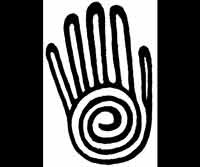
Faces of the Hand 1996
Distributed by Bullfrog Films, PO Box 149, Oley, PA 19547; 800-543-FROG (3764)
The National Film Board of Canada, Studio B
Director n/a
VHS, color, 29 min.
High School - Adult
Anthropology
Date Entered: 11/09/2018
Reviewed by Rebecca Graves, J. Otto Lottes Health Sciences Library, University of Missouri-ColumbiaLanguage is frequently held up as the last line separating humans from other creatures; however, it is our hands that make us truly unique. With our opposable thumbs comes the ability not only to make fine, intricate motions, but also to change our world. Tamas Wormser takes the viewer on a fascinating and lyric journey showing the part that our hands have played in determining our culture.
Often overlooked, the sense of touch is essential. As infants we will die without it; and, for all ages we use touch to connect, to communicate, to heal. All this we do with our hands, frequently underestimating their importance until they are injured. Then it is the surgeon's hands that repair ours.
Our culture is largely based upon eye-hand coordination. We use our hands to craft instruments such as the violin as well as to play them. We supplement our verbal communication with hand signs and gestures, from trading commodities and handling money at the market to baseball players to flamenco dancers. For some, such as the Deaf and monks who have taken vows of silence, gestures are speech. Whether we bake bread by hand, or build machines to do it for us; whether we study martial arts or build weapons, we rely on our hands.
In all facets, the marks of our hands are there. From the earliest cave paintings to fingerprinting today, hands have been used as our signature. We go to the palmist to decipher our character. We put them together as a sign of prayer, and reach them out as a help to friends. In our hands rests our humanity.
This is a well crafted documentary that poetically weaves together multiple ideas and images. Of excellent quality, it is suitable for a wide range of ages from grade school through university. It would be particularly relevant in courses on anthropology or communication, and would also serve well in courses on art or history.